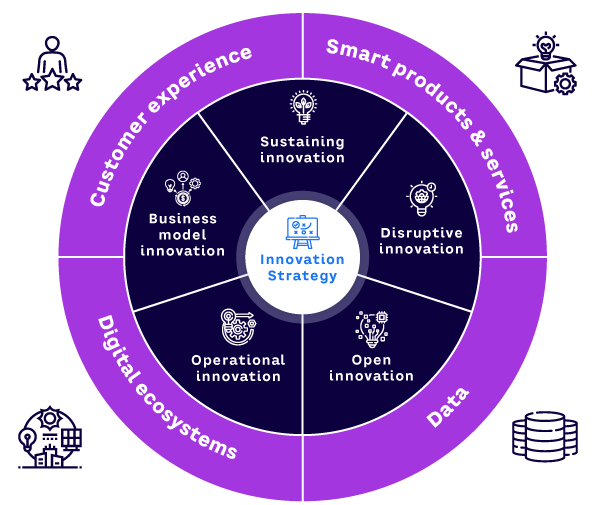LEADERSHIP EXECUTIVE UPDATE VOL. 2, NO. 2

The world is changing rapidly, and we are witnessing a plethora of significant events, including the outcomes of a global pandemic, climate change and extreme weather, global supply chain disruptions, the war in Ukraine, the emergence of innovative technologies, and more and more smart products. These are all shaping the business environment, forcing organizations to adapt and change at unprecedented speeds. Consequently, senior managers are asking themselves how their organization should respond to deal with the technological storm and what steps they should take to prepare the organization for the future. As we explore in this Executive Update, the range of actions managers must take is broad and includes, among others, the development of organizational innovation processes, digital transformation, making the organization agile, adapting ways of doing business that meet new expectations of customers, and more. One theme runs through all of these initiatives — innovation.
The saying, “You can’t stop the waves, but you can learn to surf” has never been truer. Every organization must learn to surf the waves of innovation; otherwise, it may find itself irrelevant. Business history is full of names of large organizations, including market leaders like Kodak, Nokia, and Blockbuster, that drowned in the waves of innovation. They did not know how to read the map and were too slow in identifying trends and making the right decisions.
This Executive Update aims to expand the discussion on innovation and its strategic importance for organizations in the new era. It briefly reviews the main types of innovation in a comprehensive, 360-degree manner and refers to the abundance of concepts, methods, and tools accompanying innovation, some of which have become buzzwords with multiple interpretations. To remain competitive, an organization must strategically choose the right type of innovation and implement it intelligently.
Innovation: The New Imperative
Organizations are vigorously preparing themselves for an environment rich in digital data and collaborative networks (aka ecosystems). The true outstanding characteristic of successful organizations in the current era is innovation. Innovation has long since left the bounds of R&D departments, growing into a topic that concerns every employee in the organization. The vision of most organizations today shows their desire to become innovative organizations. It is now a “must have,” not just a “nice to have.”
Digital technologies form an extensive infrastructure for innovation in various subjects and economic sectors. Examples include industries with high levels of robotics based on Industry 4.0; digital banks that operate without branches; universities and educational institutions that offer distance learning experiences and virtual spaces; virtual health services; shops and supermarkets that enable e-commerce and home delivery; the Metaverse, which allows companies to advertise and do business in a virtual space; and more. When it comes to innovation, particularly digital innovation, it is no exaggeration to say that the sky (and soon space) is the limit.
Think for a moment about the modern business environment in which digital titans like Amazon, Apple, Meta, and Google, and global competitors like Domino’s Pizza, Uber, Airbnb, Tesla, and many others operate. This business environment, which is evolving at an exponential rate, is creating an unstoppable storm of disrupting existing business models. The answer to the challenges they pose is mainly through innovation.
A 360-Degree Look at the Innovation Process
Two dimensions comprise the innovation processes in organizations: the strategic/methodological dimension and the applied dimension.
The strategic dimension is a variety of strategies and methodologies through which organizations can develop and drive innovation. It includes:
-
Sustaining innovation
-
Disruptive innovation
-
Open innovation
-
Operational innovation
-
Business model innovation
The applied dimension is a selection of key applications and tools in which the organization can realize innovation. The following is only a partial list of possible applications and tools for realizing innovation:
-
Smart products and services
-
Customer experience (CX)
-
Data
-
Digital ecosystems
Figure 1 — the innovation strategy model — illustrates the two dimensions of innovation. In the center, we see the variety of innovation strategies, while the outer circle shows the applications and tools through which an organization can implement its chosen innovation strategy. Next, we briefly review each strategy and the tools for implementation.

The Strategic Dimension
Sustaining Innovation
Sustaining innovation refers to development processes that focus on improving existing products and services and exploiting the organization’s current business model. This strategy is designed to meet the needs of the business’s traditional clientele and is a linear process characterized by a relatively high level of predictability, planning, certainty, and control. The organization operates in its “home field” among familiar customers, existing contact channels, and business processes that are within its strengths.
Apple’s iPhone upgrades are an example of sustaining innovation. After the breakthrough of the first iPhone, which disrupted market leader Nokia, subsequent releases of the iPhone have offered incremental improvements in the device’s features, responding to the “wants” of customers, such as continuous improvement in camera resolution.
Disruptive Innovation
Innovative organizations understand that to generate value for their customers and protect their market share in the emerging technology market, they must simultaneously promote both types of innovation, sustaining and disruptive. This requires the organization to have a dual capability, as the two processes require capabilities that are sometimes contradictory and even competing.
Disruptive innovation is a process that focuses on developing new products, services, or business models, outside of the organization’s core business. The disruptive product may initially perform poorly compared to competing products but is simple to apply, accessible, and cheaper than similar products. It typically starts at the bottom of a market or in entirely new markets that old companies find unprofitable and therefore have underestimated or even ignored the “discount” product. Over time, the innovative product improves and expands its grip on the market, eventually pushing out old and established competitors. These types of developments have the potential to disrupt the market in their field and beyond. For example, Netflix eliminated video giant Blockbuster through its streaming model.
Another example is OpenAI’s ChatGPT, a generative artificial intelligence (AI) tool that threatens the business models of high-tech giants due to its ease, speed, and accessibility to a wide range of businesses and individuals. This technology threatens powerhouse companies like Google, whose core business is a search and advertising engine; social networks like Twitter, Instagram, and TikTok; and even industries like academia, education, entertainment, healthcare, and security services.
Disruptive innovation is essentially a chaotic exploration process accompanied by a high level of uncertainty and risk. The organization experiments with a new process that requires knowledge and abilities not found within the organization. It must test its way to the market with a new product or business model, which will create value for an unfamiliar clientele. Leading such a process requires managers with an entrepreneurial nature and a high degree of courage, who are ready to take risks, fail, and learn quickly.
Open Innovation
Open innovation is a business strategy that encourages the flow of ideas, knowledge, and resources into and out of a company, with the aim of accelerating internal innovation while also expanding the market segments for the organization’s innovations. Unlike traditional “closed” innovation, where a company usually keeps all its R&D activities within the organization and relies only on its employees for new ideas, open innovation represents a decentralized concept of innovation. It is based on the fact that knowledge is now widely distributed, and valuable ideas and developments can come from outside the company. Companies should actively seek external sources of innovation at the same time they pursue internal development efforts. The company’s business model determines which innovations to release from within and which to seek from outside the company.
Open innovation helps organizations remain competitive and flexible in a frenetic and disruptive market. It makes it possible to speed up time to market and respond quickly to new opportunities and threats. It also provides access to a space for new ideas, saves on R&D costs, and spreads risks. All of these become powerful strategic tools in a market where new technologies and business models emerge regularly, the pace of change is fast, R&D costs are high, and returns are uncertain.
Open innovation is implemented in a variety of ways, such as crowdsourcing through online platforms and hackathons; purchasing technology or intellectual property (IP) from external sources; collaborating with industry companies, research institutions, or government agencies to develop new products and services; or open source developments where the company’s IP is available for use by others in exchange for access to the IP of others.
The open innovation strategy is exemplified by market leaders such as toy company LEGO. The company uses the LEGO Ideas platform, which allows fans to submit their own designs for LEGO kits. The selected designs are candidates to become an official product. In a similar way, General Electric (GE) operates GE Garages, a program that invites inventors and start-ups to use its manufacturing resources, such as 3D printers and machining equipment, to develop new technologies and ideas for the company’s products and services. NASA implements a variety of programs, such as the NASA Tournament Lab, which invites individuals and organizations to submit solutions to specific challenges in exchange for monetary prizes.
Operational Innovation
Operational innovation examines the business processes that an organization carries out and looks for new ways to perform those processes in order to add value to the customer. The approach is cross-organizational rather than limited to one department or unit. Every organization performs a wide range of business processes, such as receiving customer orders, developing new products, purchasing raw materials and parts, manufacturing products, packaging them for delivery, producing invoices, and hiring employees.
Typically, organizations define their business processes at a particular time and do not change them for years. The introduction of a new information system, such as those for enterprise resource planning, customer relationship management, or supply chain management, presents an opportunity to review and redesign processes supported by the new system rather than replicating the existing situation and adapting the new system to current processes. However, even organizations willing to change their processes often do so as a one-time operation and fail to periodically evaluate their relevance and ability to meet customer expectations or take advantage of new digital technologies.
Operational innovation, also known as “reengineering,” rebuilds business processes to optimize them and deliver value to customers and the organization. Reengineering can shorten the time from development to the delivery phase, reduce the number of steps required to approve operations, identify new ways to enhance customer service, and more. Despite its many benefits, organizations often overlook operational innovation and instead focus on other strategies, such as new products or markets.
Business Model Innovation
The business model describes how an organization generates value for its customers and how it generates profit if it is a for-profit organization or brings value to customers if it is not. Analyzing the existing business model and searching for innovative ways to provide additional value is a significant strategy for organizations to leverage opportunities and improve competitiveness in a dynamic market. A new business model can create new growth engines and new markets for the organization. Sometimes, a new business model accompanies the development of a disruptive product or service. In many ways, developing a new business model is the “icing on the cake” in the digital transformation process.
An example of changing the business model could be transitioning from selling computing equipment to a service where the customer pays according to usage (usage-based). Many companies currently offer cloud services, for example; Amazon Web Services (AWS), Microsoft Azure, and Google Cloud are part of this trend. The Israeli government is currently in the midst of a huge project to transition government ministries to the new government cloud model, the Nimbus project. Another example is Netflix, whose first business model involved sending envelopes with a DVD to customers’ homes through the mail instead of renting videos at Blockbuster branches.
Sometimes, the new business model is a disruptive innovation itself, such as Spotify’s freemium model that accelerated the transition from music downloads to streaming and disrupted Apple’s iTunes business model. Japanese company Daiken allows customers to purchase “air as a service” instead of purchasing air conditioning systems. Today, we see the banking industry beginning the process of transitioning to a digital banking business model. A similar phenomenon is occurring in the insurance industry with the emergence of direct and digital insurance companies.
The Applied Dimension
Smart Products & Services
Digital technologies have brought about a revolution in products and services. Once, products were mainly physical, such as cars, air conditioners, and electric toothbrushes, consisting of mechanical and electrical parts. However, now almost every physical product can contain technological components, such as a processor, memory, software, means of communication with the Internet, and more. These digital technologies have brought a wave of innovation, turning products into smart products. These new smart products offer options that until recently were considered science fiction — for example, smart homes with lights that turn on automatically and blinds that rise as soon as you enter the house; cars with adaptive cruise control that recognizes other cars and adjusts the speed automatically; drones that can transport goods and land them at the customer’s home; aviation engines with lots of sensors that can control the functioning of the engine and warn of any malfunction; and more. Even cities have become smart, with traffic lights that understand the traffic situation and allow traffic to flow more smoothly and streetlight poles that detect traffic and turn on or off accordingly.
The ability to insert digital components into every product, the use of analytics based on big data and AI/machine learning, and Internet of Things (IoT) technologies capable of connecting every product to the Internet have resulted in a huge wave of innovation in products with personalization capabilities and potential for developing products that support the construction of innovative business models. Digital technologies expand the functionality of products and oblige organizations to rethink their products, learn how to bring new value to customers, and grasp how to compete in new ways. One new capability of smart products is their ability to transmit data and receive remote commands. For example, Michelin has inserted sensors into its tires to collect data on mileage.
CX Innovation
Customer experience refers to everything an organization does to prioritize customers, respond to their changing needs, and manage their journey. In a highly innovative digital world, where customer expectations and needs change frequently, constant innovation in CX is essential for an organization to remain competitive and create relevant value for its customers.
Focusing on the customer as the basis for innovation is the main principle in the “job to be done” concept developed by disruptive innovation guru Clayton Christensen. According to Christensen, customers “rent” a product or service to fulfill a concrete need, such as booking a vacation, getting from one place to another, or insuring an apartment. Companies that focus their innovation on meeting this need throughout all stages of the customer journey, both functionally and socially, will achieve differentiation in the market and better deal with disruptions. In an age where smart technologies and data are available to every business, it is a constant challenge for an organization to produce an innovative and differentiating CX.
Let’s examine several principles common to companies like Uber, Netflix, FedEx, Amazon, and IKEA that help create systematic innovation in the customer experience:
-
Understanding the customer’s needs — the ability to “put yourself in the customer’s shoes” to authentically learn about the needs, desires, and pain points, as well as how customers perceive your brand. The stream of data accumulated from interactions with customers on various digital platforms, smart products, and wearable technologies such as smartwatches and fitness sensors is a goldmine for organizations that know how to leverage it. It enables the organization to build a multichannel solution (omnichannel) that is personalized (personalized CX) and focused on value. These characteristics set a standard for innovative CX for any organization that aims to remain competitive in a digital and smart technology–oriented market.
-
Building a CX-first culture — a customer-focused organization is a culture that largely depends on the management concept that places the customer at the center of the strategy. Jeff Bezos’s principle — the basis of Amazon’s concept of innovation — represents this concept: “We innovate by starting with the customer and working backwards.”
-
A strategic plan for CX — linking CX to creating business value, directing resources to those innovation directions that will create an impact, and defining a detailed roadmap where early successes feed the further steps of change.
-
Ability to give more — analyzing customer journeys, the interactions at every touchpoint, identifying gaps, and introducing new solutions, sometimes based on AI. These are the tools that enable the organization to constantly renew the value proposition and continue to excite its customers with solutions for current and future needs that the customers still do not know how to ask for.
-
Involvement of employees in building the CX — employees who regularly interact with customers are sometimes the first to recognize changes in customer needs and offer innovative solutions. Keeping employees engaged and leveraging their insights is fundamental to creating CX innovation.
Innovating with Data
Digital technologies generate huge volumes of data. Some of this data comes from customer Internet activity — from the operation of smart products purchased to the social networks to which they belong. You may have heard the saying, “Data is the oil of the digital age.” There is no doubt that data has become a strategic resource for organizations and can be fertile ground for innovation. Organizations must know how to manage large volumes of data, ensure data quality and security, and more. Organizations can use data to promote innovation in areas such as analyzing data from products, improving decision-making processes, analyzing faults in production lines, and predicting various phenomena.
For example, Babolat, a leading manufacturer of tennis rackets, has turned its tennis racket into a smart racket by integrating sensors and Bluetooth connections into its product. This enables the collection of data on the tennis player’s performance in real time, which is transmitted to display boards on the court and to smartphones. When the game is over, the player can see and analyze performance and compare it to past performance or that of colleagues or competitors. The Otis elevator company, along with its competitors, integrates sensors in elevators and transmits data via IoT about the elevators’ performance in real time. This data is analyzed to discover faults before they occur. Medical equipment companies receive data from sensors installed in their products to monitor and generate alerts on the customers’ medical conditions and to recommend medications.
Digital Ecosystems
The use of digital technologies, especially application programming interfaces (APIs), which allow different applications to communicate and transfer data between them, represents a new and inexhaustible source of innovation and value for customers. An organization can create an extensive digital network of business partners from various fields that complement the organization’s products (collaborators) and lead to the construction of a digital ecosystem.
For example, John Deere, an agricultural equipment manufacturer, provides a solution for the management of agricultural farms by combining data from its own agricultural equipment with data from companies that provide weather or agronomic information, drones that use optical sensors to check crop quality, and companies that produce pest-control materials and fertilizers.
Ford has built an ecosystem of partners that includes car dealerships, garages, insurance companies, and even coffee shop chains like Starbucks and fast-food chains like KFC and Pizza Hut. This allows customers to order coffee and other products directly from their vehicles at the nearest branch and have them prepared for self-collection from the drive-thru. The potential for developing relationships with other partners such as gas stations and parking lots is enormous.
The ability to connect digitally between organizations from different industries opens up opportunities for innovation, such as joint promotions and customer clubs, and has the potential to create unique value for customers.
Conclusion
Each of the innovation strategies in the strategic dimension of the model — sustaining innovation, disruptive innovation, open innovation, operational innovation, and business model innovation — can be implemented through applications and tools, such as products and services, CX, and data, or through an ecosystem of partners. For instance, improving innovation can be seen in Apple's iPhone device, expressed through the series of upgrades to iPhone features that Apple releases every year or the improvements that Amazon makes in the operational functions of its voice assistant Alexa.
Lemonade, the technology-based insurance company, is a prominent example of disruptive innovation and innovation in the business model, implemented through innovation in CX. Lemonade has created a disruption in the insurance market by turning the traditional, frustrating process of purchasing a policy and handling claims into a friendly online service. With the help of a direct business model based on AI, big data, and an improved interface, the company offers fast, cheap, and personalized insurance services.
In an era where innovation is imperative, organizations that strive to remain competitive and create value for their customers must drive innovation processes, choosing innovation strategies that will advance the organizations’ business goals and selecting the best tactics to implement those strategies.




